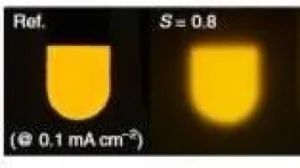Achieving high efficiency in OLED-based devices is often accomplished by means that include the use of macroscopic lenses or microscopic internal light extraction structures. Such solutions are not ideal in that they can make the OLED difficult to fabricate as well as reduce device flexibility and/or planarity.

A team of researchers led by Professor Seunghyup Yoo with the School of Electrical Engineering at the Korea Advanced Institute of Science and Technology (Kaist) (Daejeon, Republic of Korea) has undertaken research to address this issue.
A recent article by the team on this subject is entitled “Lensfree OLEDs with over 50% external quantum efficiency via external scattering and horizontally oriented emitters.” It was published on line in Nature Communications (2018). The first author on the paper is Ph.D. candidate Song Jinouk. A copy of the article can be found here.
The approach adopted by the team is based on the use of external bulk scattering. In their article, the team started by noting that this approach is not novel in that it has been the subject of previous investigations. They go on to point out that the previous research mostly consisted of experimental investigations. In their latest research, the team took a different tack by starting with a theoretical analysis that was used to predict device structures that maximize OLED efficiency. The analysis included use of a technique called radiative transfer theory.
In this theoretical approach, a scattering film is treated as an infinite homogeneous layer and describes a change in optical flux along a given direction due to the absorption, scattering and emission that can occur during light propagation. In their study, the OLED and the external scattering layers were considered as a whole rather than as two separate entities. That is, the researchers combined the mathematical description of the scattering phenomena with the optical model for light emission within an OLED. Using this approach, the researchers were able to predict the characteristics of many devices having a variety of configurations. By this means, the team was able to theoretically predict the optimal combination of scattering layers and OLED architectures that produced maximum efficiency.
Following this theoretical analysis, the team fabricated the optimal light scattering film and incorporated it into OLEDs with orange emitters having a high degree of horizontal dipole orientation. The figure below contains photos of a series of devices produced by the team to investigate the effects of scattering on the characteristics of the output light.
 Photographs of OLEDs with SiO2-embedded scattering layers according to scatterance (S)
Photographs of OLEDs with SiO2-embedded scattering layers according to scatterance (S)
Since the term scatterance is not common, note that it is defined as the fractional part of the incident power that is scattered out of a light beam into all directions.
The article written by the team concludes with the general statement that they have shown that a high degree of forward scattering can play an important role in increasing device external quantum efficiency. More specifically, the researchers report that, combined with horizontally oriented emitters, OLEDs equipped with particle embedded films tailored for intensive forward scattering achieved a maximum external quantum efficiency of 56% and power efficiency of 221 lm/W. Such performance is represented as one of the highest efficiencies ever realized for an OLED device without the help of a macroscopic lens or internal light extraction structures. In addition, they report minimal angular color shift.
The article contains a great deal of technical information on the test devices, the means used for their evaluation and the results of the measurements. Additional top level results reported in the article include that:
- A scattering medium with a high asymmetry parameter, achievable using low ?n and relatively large diameter scattering particles, is essential in achieving a high maximum achievable external quantum efficiency over a wide range of scatterance.
- A high degree of horizontal orientation of dipole emitters is still important even when used together with an external scattering medium.
The approach developed by the team is represented as compatible with low cost, large scale fabrication and, most importantly, does not interfere with any of the electrical properties of the OLED. In addition, the approach is claimed to be particularly applicable to lighting and wearable devices. -Arthur Berman
Korea Advanced Institute of Science and Technology, Seunghyup Yoo, [email protected]

